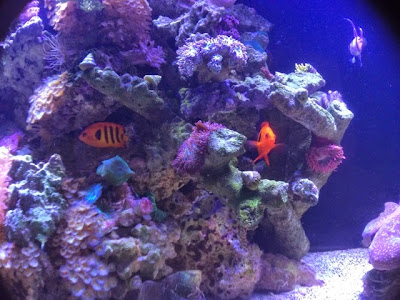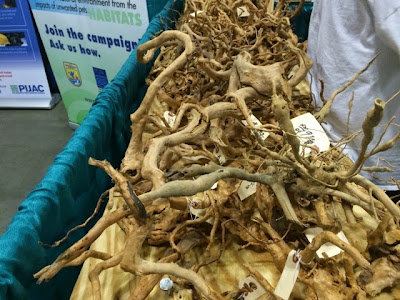How much Live Rock is enough for (insert Gallon #) Tank?
This is one of the most commonly asked questions among many new hobbyists.
So why live rock? What kind of live rock? How much?
 |
| Newly set up tank with Bare Tonga Live Rock |
Liverock serves several functions in the saltwater aquarium:
1. Landscaping- Aesthetically, this is one of the reasons people want to get a salt water fish tank- to resemble a part of the ocean at your own home!
2. Landscaping- Place holder, live rocks serve as a foundation for any corals you wish to encrust over and grow onto.
3. Landscaping- Housing complex, in the wild, the reef, live corals and dead corals (live rock) serve as housing for both fish and numerous invertebrates. This provides security for your fish's night time resting as well as a territory separator should you have an aggressor in the tank.
4. Maintenance- Since live rocks are primarily composed of coral skeleton and fossils, they are extremely porous just like our bones. The porous structure enables rocks to house an enormous amount of bacteria to help breakdown wastes in the water column.
In General, most aquarist recommend 1.5-2lb of live rock for every gallon of water volume. This figure is only for reference and often times very successful keepers are able to use much less rocks with compensation of other means such as an extremely efficient filtration system. In all of my current tanks I use an average of .7-.9 lb/gallon. But the key is for the tank to find its perfect equilibrium, then things will settle down and stay stable.
There are various types of live/dry rocks one can establish their aquariums with:
Live rocks- like these seen in
LiveAquaria, these are collected from the tropical coral reef and are packed with freshly dead algae/critter plus an abundance of marine bacteria to start your new tank's cycling. It is advised to "cure" these rocks as you let it sit in an aerated tank and allow the excessive ammonia/nitrate to be eliminated before you add them to your tank. They come in various shapes and sized. Some of the most popular ones are Fiji live rock, they are typically more rounded with rugged edges and very porous. There are also rocks from Tuvalu, Tonga, and other areas of the South Pacific to offer landscaping options with shelf and branch like rocks.
Dry rocks- These are rocks mined from the land. They are not "live" as they are dry, such as the ones sold by
Marco Rocks. But the composition of these rocks are the same as live rock- coral fossils. So once you place them into the water, bacteria and marine organisms will culture the dry rock and turn it into a full functioning live rock. Compare to the live rocks, dry rocks are less mysterious as you do not need to worry about introducing harmful or hazardous organisms into the tank along with it. But it will take a bit more patience as you must wait for the rock to mature and be cultured.
Artificial rock- These are "man-made" liveroks that looks and functions like live rock. Such as the rocks produced by
Realreefrock. They are artificially infused with all the necessary bacteria for your tanks cycling and waste processing. And since they are artificially produced, they have less impact to the natural reef.
LiveRock are not cheap, especially because of their weight often times you must also pay for expensive extra shipping cost. My personal suggestion is join a local fish club or keep your eyes on Craigslist, wait until someone is selling off their rocks, not only the rocks are much less expensive, easily accessible, no shipping charge, but also the rocks are already cured, cultured, and all ready for you to use. Unless, off course, if the rocks are currently covered with undesirable organisms then you might have some heavy cleaning on hand.
Good luck rock hunting!


























